
|
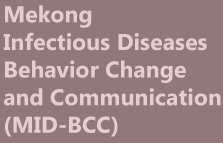
|
|
<< MID-BCC home page Blog Home ArchiveBy MonthJuly 2012 (2)June 2012 (1)May 2012 (3)April 2012 (5)March 2012 (1)By CountryCambodia (4)Lao PDR (4)Malaysia (1)Mozambique (1)Vietnam (2)By ProjectMID-BCC (9)PREVENT Project (3)
|
Risk Communication Training in Cambodia: Meet the Trainers in Kampong Speu ProvinceBy Cecile Lantican Trainers in Action
The participants demonstrated how they can mobilize community leaders and join a community forum in an event of an outbreak. In the role play, two members of a community council used communication materials to stress the message of reporting.
In a smaller group, the participants demonstrated the working relationship among district veterinarians and health workers who were tasked to compose the rapid response team. In the scenario, one participant who assumed the role of the communication officer from the district health department showed the clear message that the team should remember when they share information to the community. The scenario enabled the participants to understand better the communication roles and responsibilities of the rapid response team.
This scenario showed he communication act between a village chief and a village veterinarian. The man in striped shirt, the village chief heard about reports of dying poultry in his village. Being responsible to his village, he was asking the village veterinarian (man in white long sleeved shirt who is a real agriculture officer and knew H5N1) about technical description symptoms of H5N1. The village veterinarian discussed the symptoms and shared the message of prevention against avian influenza. One observer was taking down notes on the conversation that was taking pace - noting the accuracy of the message, listening skills, skills of questioning and probing, non-verbal communication skills of the village veterinarian. On the third day, we did a half-day orientation of private clinicians, pharmacist’s owners and pharmacy clerks. Twenty-eight participants attended out of the 20 expected invitees. There were 14 males and 14 females. The purpose of this orientation was to provide the participants correct knowledge of the disease, its symptoms, prevention and reporting/referral of cases prescribed by the government. According to reports, in most of the human cases that occurred since 2006, patients were misdiagnosed when sought medical attention. I requested Tongngy to help me interview some participants.
“I find the orientation useful. The information provided both by the speaker from the health officer from CDC and the agriculture officer from NaVRI is very useful. This my first time to hear such details of the disease. In my practice, I most of the time have treated cases of seasonal flu, but not experienced seeing the clinical symptoms of H5N1.”
She is Ms. Ven Nem, (on left) 32 years old who has been a village health volunteer for almost four years. She shared with us, “There was information about bird flu in the village. Together with the district health, we warned the people, but they do not listen to us. The 21st case was a relative of mine. Now, my family has been careful. This meeting is very useful to me – I have learned many details about the symptoms and how to protect ourselves.”
Wrapping up! The success of conducting the risk communication depends on many factors --- preparation, logistics, teamwork, learning environment, but more important considerations are the background and training skills of the trainers. In the Kampong Speu training experience, the trainers exerted effort on showing what they can deliver to make people understand how to communicate the risk of H5N1 in different ways. In simple role plays of outbreak scenarios, they showed how interpersonal communication occurs within other contexts like groups and organizations. Seeing the trainers in action, I believe, their interpersonal communication skills can be improved through knowledge, practice, feedback, and reflection. At lunch time, we had our taste of Cambodian exotic food in a nearby local resort. We waited for more than 30 minutes before the chef was able to cook our food. The lunch was sumptuous. However, we were surprised by the coming of one more guest.
This blog is the second part of the earlier post, MID-BCC in Cambodia: Training the Frontlines on Risk Communication. MID-BCC project is funded by USAID/RDMA. Photos by Cecile Lantican 2012 | FHI 360 |
|
|
Copyright© 2011 FHI360 1825 Connecticut Avenue NW Washington, DC 20009 - 5721 
The Mekong Infectious Disease Behavior Change and Communication Project is funded by the United States Agency for International Development (USAID)/Global Health under Client Associate Award Number GHN-A-00-09-00002-00 under Leader Award (C-Change) No. GPO-A -00-07-00004-00 and managed by FHI 360. The information provided on this site is the responsibility of FHI 360 and is not official information from the U.S. Government and does not represent the views or positions of USAID or the U.S. Government. |
||
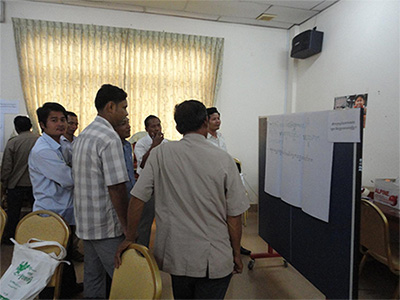 Participants were divided into groups and were tasked to discuss and share their insights on basic concepts – communication, interpersonal communication, usual habit, and behavior change. This is the leveling off exercise before the technical input so that trainers would know what the participants know and what do they understand about communication in their context and experience.
Participants were divided into groups and were tasked to discuss and share their insights on basic concepts – communication, interpersonal communication, usual habit, and behavior change. This is the leveling off exercise before the technical input so that trainers would know what the participants know and what do they understand about communication in their context and experience. 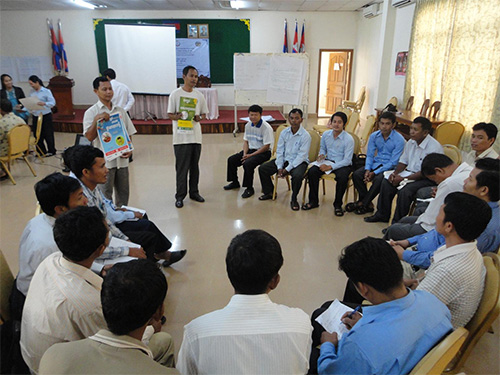
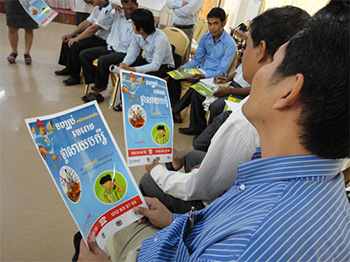 The scenario also demonstrated how interpersonal communication takes place in a group interaction, making use of communication materials where there may be a large number of individuals involved in a communicative act.
The scenario also demonstrated how interpersonal communication takes place in a group interaction, making use of communication materials where there may be a large number of individuals involved in a communicative act.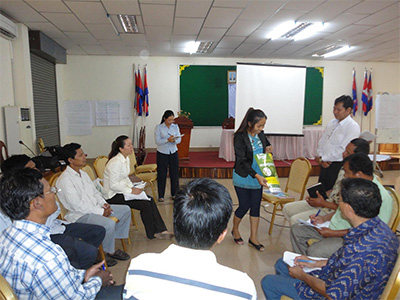
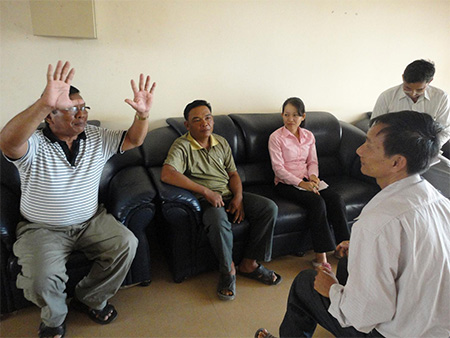
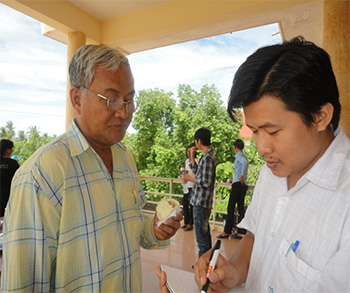 Tongngy asked Dr. Yem Run (on the left), 62 years old who runs a small clinic in the town about his impression of the activity.
Tongngy asked Dr. Yem Run (on the left), 62 years old who runs a small clinic in the town about his impression of the activity.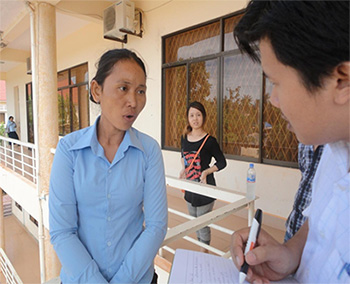 We also asked a village health volunteer who came from Toul Sala village, Borseth district. This was the same village where the 21st case of H5N1 in humans happened.
We also asked a village health volunteer who came from Toul Sala village, Borseth district. This was the same village where the 21st case of H5N1 in humans happened. 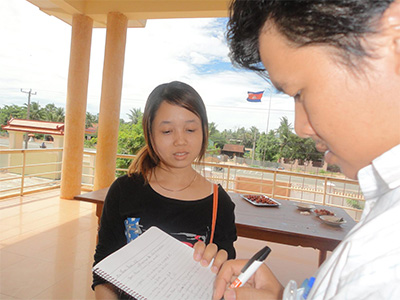 This young lady volunteered to talk with us. She is Saing Chan Noun, 22 years old and working as a pharmacy clerk with her auntie who runs a drug store within the vicinity. She expressed that this orientation was helpful and important for her. Based on her experience, people just tell her the medicine they want to buy, but not experienced about specific medicine for H5N1. Given the information on the symptoms of the diseases, she was now aware about her work – to ask clients first about the problem before selling them the medicine that is asked for.
This young lady volunteered to talk with us. She is Saing Chan Noun, 22 years old and working as a pharmacy clerk with her auntie who runs a drug store within the vicinity. She expressed that this orientation was helpful and important for her. Based on her experience, people just tell her the medicine they want to buy, but not experienced about specific medicine for H5N1. Given the information on the symptoms of the diseases, she was now aware about her work – to ask clients first about the problem before selling them the medicine that is asked for. Here she is, the next topic of my blog, maybe in my next visit to Cambodia.
Here she is, the next topic of my blog, maybe in my next visit to Cambodia.